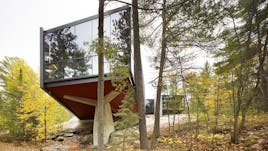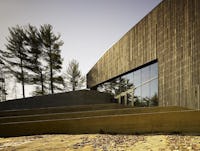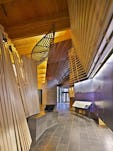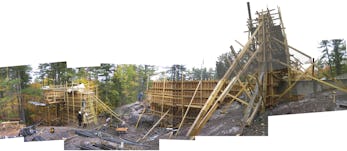French River Visitor Center: Alban ON
BAIRD SAMPSON NEUERT ARCHITECTS















Prior to forming RVTR and while still an Associate at Baird Sampson Neuert Architects in Toronto, Geoffrey Thün was central in developing the design for the FRVC. Many aspects of the project, including the experiential sequencing of space, use of landscape in shaping form and approach to detailing developed through this project remain important to the way we approach our current built work.
The French River marks the transition to the Canadian Shield, a landscape of granite scraped bare by the passage of glaciers. In its descent from its headwaters, the River transforms from a fractured granite gorge into a vast delta of sculpted granite islands and outcrops. Designated as Canada’s first Heritage Waterway, the River served as a trade route between First Peoples, and for Europeans, was the primary route for inland exploration of the continent . It has been a primary source of uniquely Canadian mythology, inspiring native pictographs and European depictions of heroic river journeys, and contemporary work from the Group of Seven.
The project establishes an architecture of the River, defining and invoking its physical qualities and cultural legacy through an integrated approach to architecture, landscape and exhibit environments. Flowing across an archetypal landscape of rock and water, the visitor experience is organized along a continuously inclined topography of found and constructed elements that establish an interpretive and spatial armature for the project, which interprets the River’s descent from its headwaters at Lake Nippissing to its delta at Georgian Bay. The compact exhibition overlays multiple themes of cultural, geologic and natural histories to depict many and simultaneous perspectives of the river. Cultural narratives and stories depict the multiple stakeholder perceptions of the rivers histories and are shared with visitors in five distinct dialects including those of the First Peoples for who the river remains home.
Sited upon an outcrop of exposed granite, the building has been organized into a series of terraces that respond to its sloped topography, providing a barrier-free path that connects the elevated parking area with an existing lower-level picnic zone. The terraces provide connections between interior and exterior program areas, and are sized and configured to accommodate multi-tasking of the facility for wide-ranging user groups, and to promote extended seasonal use. The entry terrace has been located southward to maximize solar aspect, and its flanking walls provide shelter from westerly winds. The events terrace is located on the sheltered easterly side of the building and is provided with a deep overhang for inclement weather. The teaching terrace serves as an outdoor amphitheater for school group presentations. The vast soffit of the exhibition hall provides an outdoor sheltered space for hikers using the adjoining trail system.
| Typology | Cultural Facilities |
| DATE | 2001-2006 |
| LOCATION | Alban, ON Canada |
| SCALE | 8600 sf |
| BUDGET | $ 4.8MM CDN |
Team
| Client | Ministry of Natural Resources, Ontario Parks |
| BSN Architects | Jon Neuert, Barry Sampson, Geoffrey Thün, Gregory Reuter, Mauro Carreño, Jennifer Anderson, Seth Atkins, Jose Uribe, Nene Stout, Mark Martin, Dieter Janssen |
| Structural | Blackwell Bowick Partnership |
| Mechanical | The Mitchell Partnership |
| Electrical | Mulvey and Banani International |
| Landscape | Harrington and Hoyle Ltd. |
| Exhibition Design | BSN with Philip Beesley Architect |
| Interpretive Planning | Apropos Planning |
| Contractor | Kona Builders Limited |
| Photography | Tom Arban |